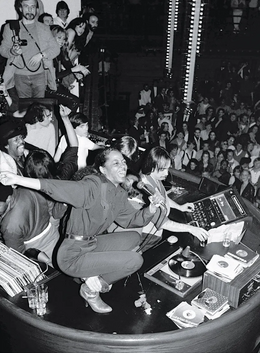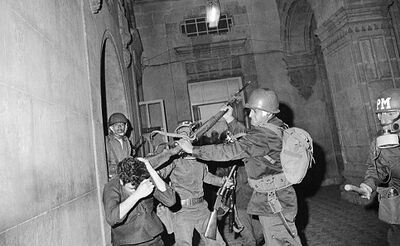Disco Revolt
 Hajo Night at the Club El Elawe, c. 1975 | |
| Date | Early 1960s to Early 1970s |
|---|---|
| Location | Elaklania |
| Outcome | Cultural movements Vida Nocturna Protest movements Concrete Movement Citizens United Elawe Peoples Movement |
Disco Revolt (Isbellan: Revuelta Disco) was a anti-establishment cultural phenomenon that spawned various political movements in its wake. Based around disco music and the night life of modern cities in Elaklania during the 60s and 70s, Disco Revolt was the first major anti-establishment movement in Elaklanian history and was at least partially responsible for some of the biggest changes in the country’s political history.
Sparked by the emergence of disco, the authoritarian rule of President Juan Esteban Cazalla, and his national policy of Nueva iluminación which banned various kinds of music for impure qualities. As the movement became more popular it gradually became less about Disco and more about social issues and criticism of the state and its ideology. Civil rights, feminism, and sexual liberation became prominent subjects within the movement which eventually led to the formation of new organizations made to promote them, the most significant being that of Citizens United.
Name
“Disco Revolt” as a term for the Elaklanian counterculture movements of the late 20th century only appeared in early 1960 when the Disco club “Gran Tono” released a single of the same name. The song by Marco Maroto would have light anti-establishment themes unlike later Disco Revolt music but would heavily criticize the president, when the song grew in popularity it would eventually be brought before the party in the National Congress as an example of moral decay.
Many would attribute the song to the ban on disco winning it even more popularity, the name of the song would be used by later bands on numerous songs and albums, until it would be used so often that it would eventually become synonymous with the counterculture in Elaklania as a whole.
Background
With the end of the Cesyllean Nuclear Crisis the Jango Era would also seemingly begin to come to an end, with the successor of the Jangoist President, Mauricio Ocampo, Juan Esteban Cazalla announcing his own plans for a new national policy that would deviate heavily from Jango’s vision. Called the "New Enlightment" or Nueva iluminación, the policy would abandon most of Jangos easy going social policies instead tightening the authoritarian grip of the state to prevent outside ideas from gaining popularity, an affront to what Cazalla saw as the perfect state that Jango had built.
Television, music, art, and theater would all be targeted by Cazalla, under Nueva iluminación they would be expected to follow a set of guidelines set up by the PRN these guidelines would be made to amplify positive attitudes towards the country, party, and its ideology.
As a result many foreign albums would be banned and made nearly impossible to get it, the Elaklanian musical scene would be enraged and the response especially in the Disco scene would be clear. Reacting to new songs calling out Nueva iluminación, Cazalla would heavily restrict Disco making it banned in all but name.
City by city
In response to the ban illegal smuggling of Disco music would become commonplace. Albums from Aosta, Druermark, and Nutarra would become highly influential with their socialist anti-authoritarian style influencing the underground scene of Disco which would only grow stronger as the music beat the government censors and become more popular.
While originally only in the Capital of Puerto Bontia, underground Disco clubs would eventually appear in every major city in the country, while some had better luck than others their appearance would have massive ramifications eventually making Disco Revolt what it is known as today.
Puerto Bontia
Ciudad Alaha
Ciudad Fernando
Nuevo Toqui
Culerbra
Culerbra was set apart from other Disco scenes because of its popularity with militant extremists. It is often considered the realist scene for this reason though much of the music and politics that would come out of the city would be extremely suppressed only finding relevance in the modern day thanks to the decline of government censorship.
The most important discothèque in the Culerbra at the time was the Rata Gorda, In 1975 the Concrete Underground, a infamous leftist terrorist organization, would be founded in the club basement. While Rata Gorda would host parties, recording sessions, and political events; the Concrete Underground would use the basement to plan attacks against the government and police.
Rata Gorda would be one of the three legendary discothèques that would be destroyed during the Days of Terror in 1982. Intel had leaked to the Revolutionary Guard that the club held rebels, so in an especially brutal display the Guard would raid the club and let it be burnt down by pro-government protesters.
It is often remembered fondly by the left as an example of tangible anti government activism, while the right sites it as proof of why Cazalla was correct in trying to curb disco’s popularity in the public.
Political movement
As Disco Revolt became more affiliated with students and anti government radicals in 1974 the political edge of the movement would start to bear fruit, protests, strikes, and even politically motivated attacks would be planned in underground discothèque with their status as the hive mind of anything anti-government being sealed.
Citizens United
Elawe People’s Movement
Culture
Disco Revolt was heavily influenced by outside cultures which had begun to enter a sort of cultural renaissance after the end of the Cesyllean Nuclear Crisis and Great Deluge. While this included many neutral nations it was predominately from nations in the ASL, their alternative lifestyles were seen as very attractive to the new generation of Elaklanians and through the Aostan advent of Disco music it was easily spread by new artists.
Vida Nocturna
Much like other countries around this time Elaklania would experience its own cultural renaissance, now referred to as Vida Nocturna or “Nightlife” Professor Inhué Moya writes “Vida Nocturna represented the opening of Elaklania to the global community, while the government bitterly rejected the notion the public eagerly embraced it, even through something as simple as music.”
Vida Nocturna was staunchly in opposition to Nueva iluminación and its fetishization of Elaklania during the 50s, in its place a new love of the urban fast pace lifestyle was born. Alongside this a number of more taboo topics were also starting to be explored, such as recreational drug use, gender, and homosexuality thanks to their heavy association with clubbing culture.
The end of Vida Nocturna is still debated upon but most scholars agree that with the beginning of the 90s and the decline of disco music that the renaissance had ended. In recent years however Neo-Nocturna a evolution of disco incorporating a variety of different musical influences has kept the original ideals of Vida Nocturna alive.
Music
Disco Revolt’s main tool in both its cultural and political appeal was Disco music, essentially beginning with the album Gran Tono by Marco Maroto disco, quickly became the biggest hit within clubs and bars within Elaklania. While after the ban it was purely relegated to underground clubs it kept its prestige and continues on into the modern day.
Elaklanian disco takes notes mainly from Aostan disco which holds the genres origins, but Ilbonese city pop and Druermarsk synth-pop were also very influential.The Influence also wasn’t limited to foreign elements, Cumbia, Samba, and even Elawe folk music were all influential to certain disco scenes throughout the country.
Important Elaklanian disco artists include: Miguel y los pájaros, Amor eterno, Raúl Illescas, and Tobías Carita. Influential artists from outside Elaklania include: Arita Taya, from Ilbon, Liberato Cittadino, from Aosta, and Christoffer Ostenson, from Druermark.



